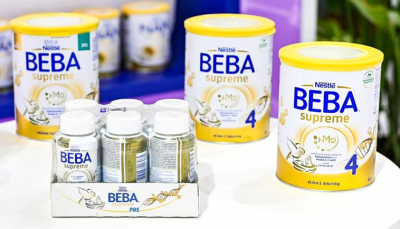Abbott study: New findings detail HMO levels in breast milk of Chinese mothers

The study found that milk with high levels of 2’-fucosyllactose (2’-FL) contains higher amounts of five other important human milk oligosaccharides (HMOs).
In breast milk containing high levels of 2’-FL – median level of 2,001mg/L – there were 1.2 times higher amounts of five other important HMOs.
The five other HMOs are 3-fucosyllactose (3-FL), lacto-N-tetraose (LNT), lacto-N-neotetraose (LNnT), 3′-sialyllactose (3′-SL) and 6′-sialyllactose (6′-SL).
Also, in breast milk containing low levels of 2’-FL – median level of 20 mg/L – it was found that 3-FL was the most abundant HMO throughout the 400 days.
Findings of this study were published in Nutrients.
The study took place in Guangzhou between March 2018 and June 2019.
Breast milk samples were collected from 335 healthy mothers at five different time points after they gave birth, specifically zero to five days, 10 to 15 days, 40 to 45 days, 200 to 240 days, and 300 to 400 days postpartum.
A total of 488 breast milk samples were collected.
Most of the breast milk samples (79 per cent) contained high levels of 2’-FL, while 21 per cent contained low levels of 2’-FL.
This study is said to be the first to report HMO changes in the breast milk of Chinese mothers over a prolonged period – up to 400 days postpartum.
In addition, while most studies classify mothers based on whether 2′-FL is secreted in their breast milk, this study classified mothers into the two groups – whether they produce high or low amounts of 2′-FL.
In the study, 2′-FL was detected in 99.2 per cent of the samples.
“Our results suggest that breast milk from non-secretor mothers also contains low levels of 2′-FL. Conceivably, 2′-FL is present at some level in most breast milk.
“This study also provided the range of 2′-FL concentrations in the high and the low 2′-FL groups, which could help future investigators understand the health benefits of different breast milk phenotypes.”
The researchers added that 2’-FL has been found to shape the intestinal microbiota, inhibit pathogen adhesion, and attenuate inflammation.
The most abundant acetylated HMO
On the other hand, the researchers found that LNT was the most abundant acetylated HMO in breast milk containing high and low levels of 2’-FL.
This revealed that LNT is a prevalent HMO present in the breast milk, regardless of the secretor type of the nursing mother, the researchers said.
Acetylated HMO contains terminal N-acetylglucosamine residues. Another example of such a HMO is LNnT.
When comparing the two, LNT levels were higher than LNnT throughout all sampling periods, suggesting the importance of LNT.
To date, over 150 HMOs have been identified in breast milk.
Oligosaccharides with terminal fucose residues linked by α 1–2, α 1–3, or α 1–4 glycosidic bonds are classified as fucosylated HMOs. Examples are 2′-fucosyllactose (2′-FL) and 3-fucosyllactose (3-FL).
Those with terminal sialic acid residues linked via α 2–3 and α 2–6 glycosidic bonds are classified as sialylated HMOs. Examples are 3′-sialyllactose (3′-SL) and 6′-sialyllactose (6′-SL).
Changes
The study found that while 2’-FL levels had steadily declined throughout the postpartum period, it was still the second most abundant HMO during day 400 postpartum, only behind 3-FL.
The findings showed that 2’-FL had decreased from a median of 2,891 in the first five days postpartum to 1,013 during 300 to 400 days postpartum.
Nonetheless, it was still the second most abundant HMO out of the six HMOs assessed in this study.
The HMO 3-FL was the most abundant 300 to 400 days postpartum, with a median amount of 1,128.
“The results of this study support the WHO’s recommendation to continue breastfeeding after the first six months of life by providing evidence that HMO levels in breast milk at 300–400 days postpartum account for 59% of the total levels in colostrum.
“Complementary foods added to an infant’s diet from six months of age cannot replace the benefits of HMOs in breast milk, as there are no food sources containing oligosaccharides with the same diversity and abundance as HMOs in breast milk, although the structure of some oligosaccharides in the milk of non-human mammals is similar to HMOs,” the researchers concluded.
They recommended that future studies could seek to find out the specific timings in which changes in HMO levels were observed.
Source: Nutrients
Six Oligosaccharides’ Variation in Breast Milk: A Study in South China from 0 to 400 Days Postpartum
https://doi.org/10.3390/nu13114017
Authors: Shuang Liu, et al





















